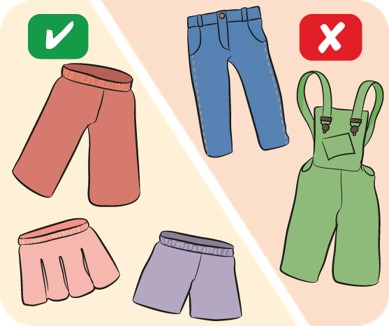Toilet training is one of the biggest challenges for parents. When to start, how to start, do you go straight to undies? Basically, being “toilet trained” means a child moves from a state of incontinence to a state of continence and it usually takes some time for children to be completely competent at using the toilet.
Generally, children are ready to toilet train between 18 months and 2 and a half years. It’s important for parents to follow the child’s lead otherwise the experience will not be successful.
Have you thought about the process of going to the toilet? To successfully go to the toilet a child must do all of these tasks:

This is a very complex skill set for a young child and we need to support them to do all of these tasks successfully.
How do you know your child is ready to start?
When you have noticed many of these signs they may be ready to start.
Nutrition
An often-forgotten aspect of toilet training is nutrition. A child can only go to the toilet if they have been consuming enough liquid and solids to warrant their body expelling the waste. Drinking plenty of water is essential, and to support toilet training encouraging your child to stop and have a “big drink” rather than regular sips of water will help their bladder to work as it should, but filling and emptying.
Poor nutrition and limited consumption of water will lead to constipation which in turn makes toilet training really hard.

Here are a few tips:
In the months prior to starting ensure your child is drinking enough water so they produce enough urine.
Take note of your child’s interests around toileting. Encourage and praise their interest and any successes.
Take your child to buy some undies.
Parent Mindset
You are going to have to be really ready to do this, and your support, encouragement and praise will really help your child and lead to success. You are going to have to be the most encouraging, over the top praising parents you have ever been.
Everyone in the household, and community (grandparents and Early Learning Service) is going to have to be involved and have the same rules. That is, undies should be worn everywhere. If grandparents are unable to support this then you will need to find a time when you can limit visits to their house for a few weeks.
Ensure the child’s routine is relatively stable and you are not adding extra stress to their life. Don’t start if you are moving house, close to expecting a new baby or starting Early Learning.

Starting
Bathroom Hygiene is a lifelong lesson
Other considerations
Most children are dry at night at 3 or 4 years, but some are still in nappies until they are in school.
Training pants are absorbent underwear worn during toilet training. They’re less absorbent than nappies but are useful for holding in bigger messes like accidental poos. Once your child is wearing training pants, dress her in clothes that are easy to take off quickly.

Pull-ups are very popular and are marketed as helpful for toilet training. It isn’t clear that they actually help. But you can try them to help your child get used to wearing underwear.
Reward charts are not that effective as children need relevant immediate rewards. Positive relevant praise works is more effective, parents who use stickers and food rewards such as chocolate can end up in a power battle with their children which does not result in the child training quicker.
Regression
Many parents will report that their child’s toilet training has regressed. Children’s development in all areas is up and down. Sometimes they seem clumsier, or they seem to forget a skill they were able to do. Children are constantly growing and sometimes the messages their body sends the brain get lost in their growth. Remember toileting starts with the bladder or bowel sending a message to the brain saying “hey, empty me!” Stay with it remain positive and encouraging and all will be good.
What if my child isn’t interested?
If your child is not interested by 3 ½ – 4 years of age then you should seek help from your GP. Below are some good online resources for you to read.
https://www.continence.org.au/
https://raisingchildren.net.au/
Written by Su Garrett
Images Reference